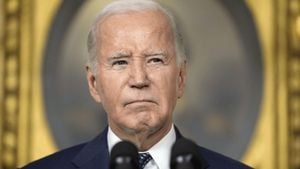Across the United States, schools are grappling with serious teacher shortages and high levels of burnout among educators. Amidst these challenges, various initiatives are being implemented to address the growing discontent among teachers. Reports from multiple states, particularly Connecticut and Montana, highlight alarming statistics concerning teacher dissatisfaction and the effects of persistent stress and burnout.
According to the Connecticut Education Association (CEA), nearly 5,000 educators are expressing significant concerns about their work conditions. The latest survey conducted by the CEA revealed startling findings: 98% of teachers reported stress and burnout as serious issues. With 70% indicating they would discourage others from entering the teaching profession, it’s clear the challenges facing educators are multifaceted.
Citing workload pressures, insufficient pay, and lack of respect, many teachers feel increasing disillusionment with their roles. CEA President Kate Dias remarked, “Our annual survey paints a stark and sobering picture of the teaching profession—one requiring urgent attention from policymakers and communities alike.” The urgency is palpable as many districts struggle to fill teaching vacancies, leading to concerns about the quality of education available to students.
Simultaneously, Montana is also seeing efforts to combat teacher shortages. The University of Montana has joined forces with local school districts to address workforce shortages through innovative training partnerships. This new initiative aims to create alternative pathways for future teachers, focusing on recruiting individuals who might succeed through less traditional routes.
According to reports from Montana, collaboration between educational institutions and local districts includes mentorships and hands-on teaching experiences for students. This approach allows prospective teachers to gain practical skills and insight, fostering excitement for the teaching profession. By creating supportive networks and providing real-world experiences, initiatives like this hope to alleviate some of the stresses associated with entering the educational field.
These programs not only seek to fill vacancies but also aim to create welcoming environments for aspiring educators. The National Center for Education Statistics has indicated serious staffing shortages will continue to plague many districts without bold actions taken soon.
Back to the Nutmeg State, the pressures facing teachers are serious not just for educators but also for students. With chronic absenteeism on the rise, teachers express concern about the lost learning opportunities for their students. Many feel compelled to offset these losses with their own out-of-pocket expenditures on supplies and resources, creating additional financial strains on already undercompensated staff.
Further complicate matters, the demands on teachers are mounting as more students face mental health challenges and behavioral issues. Teachers feel isolated, with 63% reporting dissatisfaction with the conditions they face at work. This dissatisfaction only serves to amplify the existing teacher shortage, creating a vicious feedback loop.
Joslyn DeLancey, Vice President of the CEA, emphasized the detrimental effects of political decisions made by individuals who do not understand classroom dynamics. “Students don’t want to go to teaching, and educators don’t want their friends and family to enter the profession,” she noted, underscoring the gap between compensation and responsibility teachers face.
Discussions around improving teacher salaries have materialized as a primary concern. Advocates believe sufficient pay could reignite interest among potential educators, leading to more competitive recruitment. While legislators have made some efforts, many educators feel progress has been underwhelming.
The situation begs the question: what will it take to restore the balance? For states like Connecticut and Montana, building sustainable educator pipelines involves systemic shifts, including financial investments, resource allocation, and legislative action.
This teacher shortage is not just about unsatisfied educators, but also poses significant risks to the students who depend on them. Parents and community members, too, are becoming increasingly aware of the ramifications of these issues. Schools across the country have seen teacher vacancies remain stubbornly high, leading to makeshift solutions like hiring long-term substitutes or teaching assistants, which can compromise the educational experience for kids.
Addressing burnout requires not only recognition but active engagement from all levels of government and education systems. Teachers are requesting collaborative environments, comprehensible supports, and competitive salaries to do their jobs effectively and help their students succeed. More shockingly, as reported, systems are slow to respond to these needs, allowing frustration to fester.
One potential solution being discussed is the concept of teacher residency programs, such as those starting to gain traction through universities and local partnerships. These aim to provide new educators with thorough preparation and mentorship, bridging the gap between theory and practice.
Looking forward, states will need to prioritize teacher welfare if they want to see genuine improvements. Escalated conversations surrounding teacher satisfaction, working conditions, and compensation are welcomed by associations and educators alike. For many involved, it’s about time the teaching profession gets the respect and resources it deserves.
Simultaneously, initiatives must promote wellbeing and support for teachers, who are often the first to face the fallout of ill-advised policy decisions. Reducing burdens on educators—whether through less rigid bureaucratic structures or more expansive mental health resources—will cultivate stronger learning environments.
Innovative partnerships, like those seen at the University of Montana, alongside unwavering advocacy for educators' rights and needs, could serve as the blueprint for the future. It’s about building back trust within the education system, enabling teachers to flourish and keep doing what they love: teaching the next generation of leaders.
At the end of the day, maintaining the pipeline of passionate educators is as much about the students as it is about the teachers. The discussions surrounding their livelihoods will determine not only the future of teaching but the educational system as a whole. The road is still long, but proactive measures can bring about transformative changes for educators nationwide.



